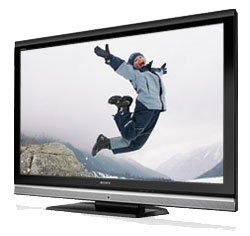
Dick De Jong
December 11, 2009
HDTV Solutions
Eco Series. Right up front, Sony clearly indicates its goals for their VE5 line of LCD TVs. Consuming about as much power as a 100W light bulb, the KDL-46VE5 justifies Sony's trumpeting this model as one of their environmentally friendly TVs.
Sony designers have even added tools like a Presence Sensor and an Energy Savings Switch to assist you in conserving even more power.
I appreciate the 46VE5's ability to slow the spinning of my electric meter. In fact, I hope that similar power saving features will quickly migrate to all new TVs. But if that is all that the VE5s had to offer, then this would be a very short review.
Happily, this 46" 1080p HDTV delivers solid picture quality, albeit in a no frills package. For example, it doesn't provide Internet connectivity. And even though it's a 120Hz LCD, many of the state of the art technologies like LED backlighting are not included.
Then again, Sony has positioned this Eco Series in the middle of its model lineup with a price tag to match, making it a great candidate for someone looking for a very good performing TV with some great energy saving features.
(Editor's Note: Sony produces two other models in this VE5 line, the 40" KDL-40VE5 and the 52" KDL-52VE5. Since they have similar specifications as their middle brother, this review can apply to all of them.)
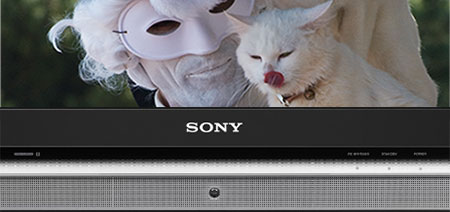
The Sony designers like to add a little flair to the standard issue piano black bezel. Oh, it's there in all of its glossiness, but below the screen, the integrated speaker cabinet sports a silver grille. And as a stylish accent, the grille and the bezel are connected with a smoky gradient strip that contains the indicator lights for Power, Standby and Timer.
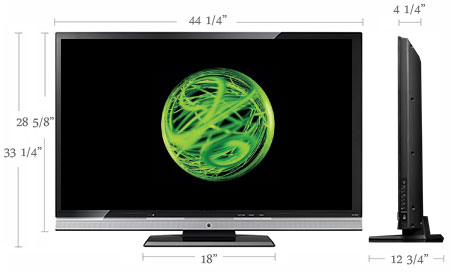
At over four inches deep and weighing almost 57 pounds when attached to its non-swivel stand, this 46" LCD requires at least two people to safely set it up.

The TV screen has a dull, slightly reflective finish, but normally, when the TV is on, you'll never be distracted by annoying glares.
Sony has flipped the convention of locating most of the connectors on the back of the TV. Instead, on the left side of the TV, what usually is a smaller convenience panel is loaded with three HDMI inputs, one VGA PC input with an Audio In (stereo minijack), an S-Video In, one Composite Video In with an Audio In, and a USB port for accessing JPEG photos or MP3 songs.
Next to this panel on the back, a second configuration includes a fourth HDMI input (with matching stereo Audio In) and two Component video (YPbPr) Ins (with matching stereo Audio Ins). For sending audio to external speakers or a receiver, an SPDIF (optical) digital Audio Out is provided next to analog L/R Stereo Outs.
In addition, a Service port is included, which can also be used to attach a Sony DMex add-on like the DMX-WL1 Wireless Video Link module.
The one RF antenna connector links to integrated NTSC/ATSC/QAM tuners. Since the tuner system is Clear QAM compatible, you can attach your cable TV signal directly into the RF connector and tune in unscrambled cable stations. Just don't expect to access any encoded channels.
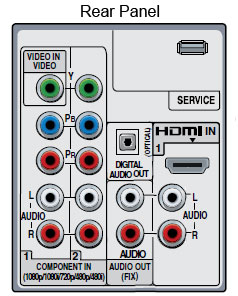
For those concerned about the DTV transition, the ATSC tuner is the key. With the proper antenna, you will be able to dial in digital signals broadcast over the air.
With the USB port on the side, you can attach flash drives, digital cameras or MP3 players and playback JPEG photos and MP3 music files on your BRAVIA.
The Photo Viewer isn't as snazzy as the one that the Sony XBR9s offer. But it's functional and it allows you to add music to your slideshows. I especially appreciate the four Photo Picture Modes, (Vivid, Standard, Original and Custom), that you can tweak to make your pictures look just the way you want.
Please note, that the KDL-46VE5 does not supply a LAN port. The TV does not connect directly to the Internet, which for many people is perfectly fine and dandy. It definitely makes setup easier and with no Internet widgets cluttering your screen, day to day operations are simpler.

Also, without all those extra Internet features, Sony is able to simplify the Menu system. Gone is the multi-directional XMB (Xcross Media Bar), Sony's proprietary menu. This BRAVIA reverts to a more pedestrian, less hyperactive format.
Continuing this no-nonsense theme, the non-backlit remote control offers big number buttons that even I can read. I also like the context sensitive Tools button, which provides a shortcut to adjustments like the Picture and Sound menus.
In an effort to reduce paper consumption and also I imagine as a recognition to the fact that most people never read the manual, Sony only includes a basic 23 page printed guide in the box. If you go to the Sony website, you can access a more expansive, well-written and interactive Reference Book.
The EPA is now publishing a list of ENERGY STAR qualified TVs. (You can find it here.) Considering the KDL-46VE5's Eco branding, it's no surprise to find it the on the list.

The EPA states that this Sony's On Mode Power is 105W and Standby Power Consumption is .3W. Based on the formula that the TV is on five hours a day and in Standby for the other 19, the Estimated Annual Energy Use is 194 kWh/year.
You need to check your electric bill to see how much you are paying for a kWh. The rate that I have been using in previous reviews is 10.4 cents. Doing the multiplication, at that rate, the yearly energy cost is $20.17.
Since manufacturers are not attaching those yellow ENERGY STAR tags that you find on air conditioners and refrigerators, you will have to study the ENERGY STAR list to see how the 46VE5 compares to other 46" TVs.
From my experience, 105W On Mode Power is extremely good for a 46" LCD, especially a non-LED backlit one. This BRAVIA uses HCFLs (hot cathode fluorescent lamps) as backlights and the Sony engineers have done an admirable job of power pinching with this technology.
But wait, there's more. If you really want to plug even the smallest power drain, Sony provides an Energy Saving Switch, on the right side of the TV. Switching it Off is like unplugging the TV. Of course, you will need to consume some personal energy to get off the couch and switch if off by hand. Face it, you could use the exercise and the world could use one less TV silently sipping juice when it's in standby mode for 19 hours a day.
Sony has implemented another eco-feature into their VE5 line that addresses the TV-talking-to-an-empty-chair syndrome. Tell me if this scenario is familiar. You are watching TV and you decide to rest your eyes for a minute. Two hours later, the OxiClean commercial wakes you up.
Sony's solution is labeled the Presence Sensor, which is a motion and heat detector located on the front of the TV. If the Presence Sensor does not detect you, after a time interval that you select, (5, 30, or 60 minutes), the backlight will automatically turn off, but the volume will remain. If you don't return after the display has been off for 30 minutes, the VE5 turns completely off.

Finally, this BRAVIA incorporates a Light Sensor that adjusts backlight intensity based on the lighting conditions in your room. As I will explain below, I am not a big fan of the Light Sensor. But I do applaud Sony for furnishing us with a wide range of tools to help control energy use.
To calibrate the TV, we use two discs, the Blu-ray version of the Digital Video Essentials DVD called HD Basics and the Spears & Munsil High Definition Benchmark Blu-ray DVD. We are playing the DVDs on the OPPO BDP-83 Blu-ray player connected to the HDTV with an HDMI cable.
We use the test patterns to adjust black level, white level, and color bias. The player is set to output a 1080p signal, which is the native resolution of the KDL-46VE5.
Before I begin the setup process, I need to talk about the Light Sensor because it warped my first impression of this Sony. As a reviewer, I don't always receive brand new TVs, therefore I can't say definitively that the Light Sensor is turned on by default. But I can state, that you should turn it off before you set up this TV.
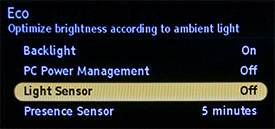
I went through one cycle of test patterns before I realized that the Light Sensor was on. The picture was just too dark and understated with the Light Sensor engaged. I simply was disappointed with what I saw. Then I found the Light Sensor control buried in the Eco submenu of the Setup menu. When I turned it off, the screen lit up and all was right again in the realm of Sony.
I am by no means a big proponent of overly bright screens. I cringed recently when I read that some guy turned his new TV on and cranked it to Vivid. But the Light Sensor, at least for me, was just too subdued.
Therefore, if you wish to follow along with me, go into the Eco menu and make sure that the Light Sensor is turned Off. You can revisit it later.
While we're flipping switches, in the Picture menu, set Advanced Contrast Enhancer, Gamma, Clear White and Live Color to Off. I suggest that you experiment with them after this initial setup.
To begin, I sample the Picture Modes. On the VE5 Series, Sony provides four choices: Vivid, Standard, Cinema and Custom.
You already know my distaste for Vivid. But Sony gives you two clearly different options in Standard and Cinema. I find both of them perfectly suitable depending on my mood and the content. Try each, if either or both appeal to your eye, great. Pick one and you're finished with setup. Lean back in your recliner and enjoy your new TV.
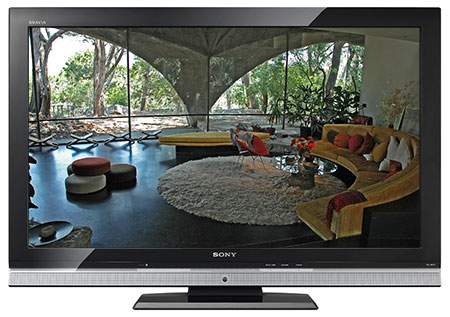
For me, I must march on through the setup. I chose the Custom Mode because I like to keep the settings unchanged in the Standard and Cinema modes for quick reference.
I start with adjusting the Color Temperature. Sony offers Warm, Neutral and Cool. I always ping pong between between Warm and Neutral. Even though it's as cold as the dickens out, I chose Neutral instead of Warm's yellowish tint. If I was watching a movie, I might decide to switch to Warm. Color Temperature is definitely a personal choice.
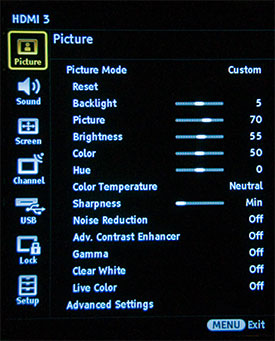
Next, I usually turn down the Backlight to about halfway. On this TV, that's 5 out of 10. Your number may vary depending on the lighting conditions in your room.
The test patterns indicated that I notch Brightness up to about 55 from the default of 50. I dropped Picture (Contrast) to 70. I left both Color (Saturation) and Hue (Tint) at 50.
The Sharpness scale runs from 0 (Min) to 30 (Max). When looking at a Safe Zone test pattern, I noticed the beginning of fringing above 7. I found that the picture was plenty sharp with Sharpness set at 0.
The whole process was quick and painless and yielded a bright and vibrant (once the Light Sensor was off) picture.
Actually, with some of my favorite reference movies, the image was just a little too amped as the shadows weren't deep. Therefore, I tried a number of tweaks.
Sometimes you have to shout, "Damn the test patterns, full speed ahead!" Or in this case, "Hard astern." I turned down the Backlight to 3. (For reference, Cinema mode defaults to 2.) And I dialed Brightness back to 50.
I then fiddled with Gamma and the Advanced Contrast Enhancer. At some point in setup, decisions become idiosyncratic, part science and part voodoo. I think of it as vibration calibration, a pinch of that, a dash of this, whatever feels right and looks good.
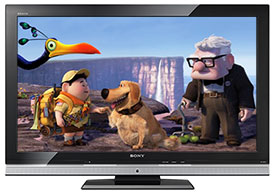
With the Up Blu-ray, I pushed the Advanced Contrast Enhancer to Medium and Gamma to Low. With this movie, that is what worked for me.
As for Live Color and Clear White, I didn't feel the need for more vivid colors or a whiter white. I left them turned off. If you do want to fine tune color, Sony provides a White Balance control, where you can adjust Gain and Bias individually for Red, Green and Blue.
Even with the limited set of adjustment tools, the KDL-46VE5 could be tuned to reproduce a wide range of looks that should appeal to a wide swath of aesthetics.
Before I leave setup, this BRAVIA is a 120Hz LCD. The theory is that by doubling the frame rate from 60Hz, fast motion will playback more smoothly with less judder.
To generate the additional frames, an in-between frame is created by interpolating the motion from the original frames by a technique called Motion Estimation/Motion Compensation (MEMC).
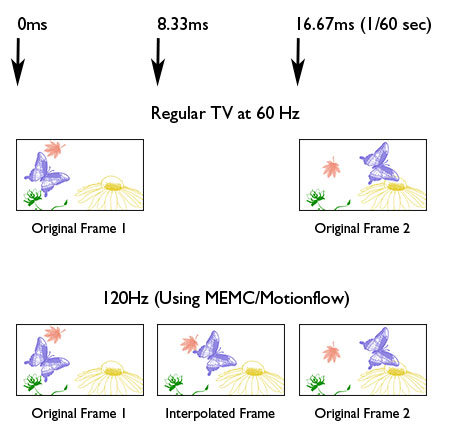
On this Sony, you can control the amount of interpolation by adjusting the Motionflow feature found in the Advanced Settings submenu. When you set it to High, MEMC is most aggressive. Standard backs it off a bit. If you turn Motionflow Off, then no interpolation is performed. The frame is just repeated two times, giving you the look of a regular 60Hz display.
I tend to leave Motionflow at Standard. Though if you really like that crisp, edgy, almost 3D look, then turn it up to High. I find that it can make films look too videoish. High also can cause minor unsightly artifacts, though with the programs I sampled it never was a problem.
Sony also provides a CineMotion setting. They describe that it "automatically detects film-based content and applies an inverse 3-2 pull-down process and a motion estimation engine to improve film content and de-interlacing performance."
There are three settings, Auto 1, Auto 2 and Off. Off doesn't apply 3-2 pull-down. Auto 1 and Auto 2 do. If you have Motionflow turned on to either High or Standard, then Auto 1 will apply the frame interpolation accordingly. Off and Auto 2 never apply frame interpolation no matter how Motionflow is set.
Experiment with the different combinations on different material to see which you prefer.
As we embark on a fresh decade, new display technologies have raised the bar on HDTV picture quality. But with quantitative measures like Dynamic Contrast peaking beyond what our eyes can perceive, we are approaching a practical ceiling.
Simply, the differences in picture quality between various high end models is becoming harder to discern. But differences definitely do exist, though to detect them, you often need the models side-by-side in a controlled viewing environment - not the showroom floor in a big box store.
Has the KDL-46VE5 reached the current picture quality pinnacle of HDTVs. No, but it doesn't lag too far behind.
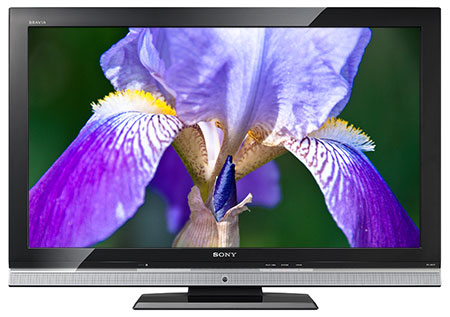
As I mentioned, its contrast, evidenced in the lack of consistent deep blacks, could be better.
And on this particular TV, I noticed a slight backlight leakage on the upper left corner, which is only visible against a dark background. Also, the viewing angle is not extremely wide. If you sit too far off center, the picture tends to wash out.
With that said, this BRAVIA TV produces a great looking image especially when feeding it high definition content. Even when displaying the more profane SD material, the BRAVIA Engine 2 digital video processor pumps out a more than decent picture.
And there were moments when this 120Hz LCD created a startlingly clear, "rewind the Blu-ray, I want to see that again" image.
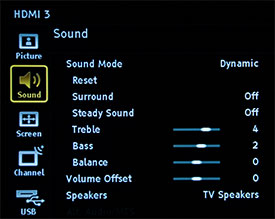
The KDL-46VE5's audio quality upholds Sony's reputation of squeezing a lot of sound out of those pair of integrated 10W speakers. The audio fidelity is good enough that non-audiophiles won't need to rush out and buy a separate dedicated audio system.
Now, you can only deliver so much aural magic with those speakers. I found that a soundbar with a separate subwoofer produces a more full bodied sound. And if you are attempting to create a home theater environment, then definitely plan on investing in a 5.1 or 7.1 surround system.
The Sony BRAVIA KDL-46VE5 Eco Series lives up to its moniker with a meager 105W power rating. Pair that with a high performance 120Hz LCD and this no-frills 1080p TV is a winner for people who don't want extra features like Internet connectivity.